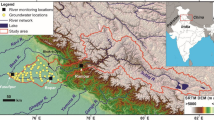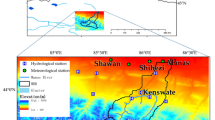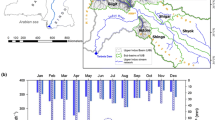Abstract
The study of snow and ice melt (SIM) is important in water-scarce arid regions for the assessment of water supply and quality. These studies involve unique difficulties, especially in the calibration of hydro-models because there is no direct way to continuously measure the SIM at hydrostations. The recursive digital filter (RDF) and the isotopic hydro-geochemical method (IHM) were coupled to separate the SIM from eight observed series of alpine streamflows in northwestern China. Validation of the calibrated methods suggested a good capture of the SIM characteristics with fair accuracy in both space and time. Applications of the coupled methods in the upper reaches of the Hei River Basin (HRB) suggested a double peak curve of the SIM fraction to streamflow for the multi-component recharged (MCR) rivers, while a single peak curve was suggested for the rainfall-dominant recharged (RDR) rivers. Given inter-annual statistics of the separation, both types of the alpine rivers have experienced an obvious decrease of SIM since 1960s. In the past 10 years, the SIM in the two types of rivers has risen to the levels of the 1970s, but has remained lower than the level of the 1960s. The study provided a considerable evidence to quantify the alpine SIM based on the separation of observed data series at gauge stations. Application of the coupled method could be helpful in the calibration and validation of SIM-related hydro-models in alpine regions.
Similar content being viewed by others
References
Adam JC, Hamlet AF, Lettenmaier DP (2009) Implications of global climate change for snowmelt hydrology in the twenty-first century. Hydrological Processes 23(7): 962–972.
Akiyama T, Sakai A, Yamazaki Y, et al. (2007) Surfacewater-groundwater interaction in the Heihe River basin, northwestern China. Bulletin of Glaciological Research 24: 87–94.
Aksoy H, Kurt I, Eris E (2009) Filtered smoothed minima base flow separation method. Journal of Hydrology 372(1): 94–101.
Arnold JG, Allen PM (1999) Automated methods for estimating base flow and ground water recharge from streamflow records. Journal of the American Water Resources Association 35(2): 411–424. DOI: 10.1111/j.1752-1688.1999.tb03599.x.
Arnold JG, Allen PM, Muttiah R, et al. (1995) Automated Base Flow Separation and Recession Analysis Techniques. Ground Water 33(6): 1010–1018. DOI:10.1111/j.1745-6584.1995.tb00046.x.
Bartelt P, Lehning M (2002) A physical SNOWPACK model for the Swiss avalanche warning: Part I: numerical model. Cold Regions Science and Technology 35(3): 123–145.
Bergström S (1975) The development of a snow routine for the HBV-2 model. Nordic Hydrology 6(2): 73–92.
Chapman T (1999) A comparison of algorithms for streamflow recession and base flow separation. Hydrological Processes 13(5): 701–714.
Eckhardt K (2008) A comparison of base flow indices, which were calculated with seven different base flow separation methods. Journal of Hydrology 352(2008): 168–173.
Feng Q, Liu W, Su YH, et al. (2004) Distribution and evolution of water chemistry in Heihe River basin. Environmental Geology 45(7): 947–956. DOI: 10.1007/s00254-003-0950-7.
Ferguson RI (1999) Snowmelt runoff models. Progress in Physical Geography 23(2): 205–227.
Freeze RA (1972) Role of subsurface flow in generating surface runoff: 1. Base flow contributions to channel flow. Water Resource Research 8(3): 609–623. DOI: 10.1029/WR008 i003p00609.
Furey PR, Gupta VK (2001) A physically based filter for separating base flow from streamflow time series. Water Resource Research 37(11): 2709–2722. DOI:10.1029/2001wr000243.
GPGS (2003) Report of the Groundwater Investigation in the Hexi Corridor. Gansu Province Geological Survey: 33–56.
Hall FR (1968) Base-Flow Recessions: A Review. Water Resources Research 4(5): 973–983. DOI: 10.1029/WR004i005p00973.
Hinton MJ, Schiff SL, English MC (1994) Examining the contributions of glacial till water to storm runoff using two- and three-component hydrograph separations. Water Resources Research 30(4): 983–993.
Immerzeel WW, van Beek LPH, Bierkens MFP (2010) Climate Change Will Affect the Asian Water Towers. Science 328: 1382–1385.
Kang E, Cheng GD, Lan YC, et al. (1999) A model for simulating the response of runoff from the mountainous watersheds of inland river basins in the arid area of northwest China to climatic changes. Science in China Series D: Earth Sciences 42(0): 52–63. DOI: 10.1007/bf02878853.
Kendall MG (1955) Rank correlation methods (2nd ed.). Oxford, England: Hafner Publishing Co.
Koskelo, Antti I, Fisher TR, et al. (2012) A new precipitationbased method of base flow separation and event identification for small watersheds (< 50km2). Journal of Hydrology 450–451 (2012): 267–278.
Laudon H, Hemond HF, Krouse R, Bishop KH (2002) Oxygen 18 fractionation during snowmelt: Implications for spring flood hydrograph separation. Water Resources Research 38(11): 1258. DOI:10.1029/2002wr001510.
Lehning M, Volksch I, Gustafsson D, et al. (2006) ALPINE3D: a detailed model of mountain surface processes and its application to snow hydrology. Hydrological Processes 20(2006): 2111–2128.
Li CB, Qi JG, Feng ZD, et al.(2010a) Parameters optimization based on the combination of localization and auto-calibration of SWAT model in a small watershed in Chinese Loess Plateau. Frontiers of Earth Science in China 4(3): 296–310.
Li CB, Qi JG, Feng ZD, et al.(2010b) Quantifying the Effect of Ecological Restoration on Soil Erosion in China’s Loess Plateau Region: An Application of the MMF Approach. Environmental Management 45(3): 476–487. DOI: 10.1007/s00267-009-9369-6.
Liang X, Dennis PL, Eric F (1994) A simple hydlrologically based model of land surface water and energy fluxes for general circulation models. Journal of Geophysical Research 99(D7): 14415–14428.
Liu ZL, Peng F, Liu XG (2012) Research Overview on Hydrological Effects of Frozen Soil. Advanced Materials Research. Advances in Chemical Engineering II(550–553): 2459–2465.
Lyne V, Hollick M (1979) Stochastic Time Variable Rainfall Runoff Modeling. In: Hydrology and Water Resources Symposium, Berth, Australia. Proceedings National Committee on Hydrology and Water Resources of the Institution of Engineers, Australia. pp 89–92.
Ma JZ, Pan F, Chen LH, et al. (2010) Isotopic and geochemical evidence of recharge sources and water quality in the Quaternary aquifer beneath Jinchang city, NW China. Applied Geochemistry 25(7): 996–1007. DOI: org/10.1016/j.apgeochem.2010.04.006.
Mann HB (1945) Nonparametric tests against trend. Econometrica 13(3): 245–259.
Mark BG, McKenzie JM, Gomez J (2005) Hydrochemical evaluation of changing glacier meltwater contribution to stream discharge: Callejon de Huaylas. Peru Hydrological Sciences Journal 50: 975–987.
Martinec J (1975) Snowmelt runoff model for river flow forecasts. Nordic Hydrology 6(3): 145–154.
Masuda K, Morinaga Y, Numaguti A, et al. (1993) The annual cycle of snow cover extent over the northern hemisphere as revealed by NOAA/NESDIS satellite data. Geographical Reports, Tokyo Metropolitan University 28: 113–132.
McCabe GJ, Wolock DM (2009) Recent declines in western US snowpack in the context of twentieth-century climate variability. Earth Interactions 13(2009): 1–15.
Nathan RJ, McMahon TA (1990) Evaluation of automated techniques for base flow and recession analyses. Water Resource Research 26(7): 1465–1473. DOI: 10.1029/WR026i007p01465.
Nayak A, Marks D, Chandler DG, et al. (2010) Long-term snow, climate, and streamflow trends at the Reynolds Creek Experimental Watershed, Owyhee Mountains, Idaho, United States. Water Resources Research46: W06519. DOI: 10.1029/2008WR007525.
Nayak A, Marks D, Chandler DG, et al. (2012) Modeling interannual variability in snow-cover development and melt for a semiarid mountain catchment. Journal of Hydrologic Engineering 17: 74–84.
Nash, JE, Sutcliffe JV (1970) River flow forecasting through conceptual models part I—A discussion of principles. Journal of Hydrology 10(3): 282–290.
Nie ZL, Chen ZY, Shen JM, et al. (2005) Environmental Isotopes as Tracers of Hydrological Cycle in the Recharge Area of the Heihe River. Geography and Geo-Information Science 21(1): 104–108.
Pearce AJ, Stewart MK, Sklash MG (1986) Storm Runoff Generation in Humid Headwater Catchments: 1. Where Does the Water Come From? Water Resources Research 22(8): 1263–1272. DOI: 10.1029/WR022i008p01263.
Piggott AR, Moin S, Southam C (2005) A revised approach to the UKIH method for the calculation of base flow. Hydrological Sciences Journal 50(5): 911–920.
Rauscher SA, Pal JS, Diffenbaugh NS, et al. (2008) Future changes in snowmelt-driven runoff timing over the western US. Geophysical Research Letters 35: L16703.
Ren J (1999) A study of chemical characteristics of snow, precipitation and surface water in the basin of the glacier No. 29 in Danghe Nanshan, Qilian Mountains. Journal of Glaciology and Geocryology 21(2): 151–154. (In Chinese)
Rutledge AT (1998) Computer programs for describing the recession of ground-water discharge and for estimating mean ground-water recharge and discharge from streamflow records: Update. US Department of the Interior, US Geological Survey: p 52.
Rutter N, Essery R, Pomeroy J, et al. (2009) Evaluation of forest snow processes models (SnowMIP2). Journal of Geophysical Research 114(D6): D06111.
Schaner N, Voisin N, Nijssen B, et al. (2012) The contribution of glacier melt to streamflow. Environmental Research Letters 7(3): 1–8. DOI: 10.1088/1748-9326/7/3/034029.
Schultz GA (1988) Remote sensing in hydrology. Journal of Hydrology 100(1988): 239–265.
Sellers PJ, Coauthors (1996) A Revised Land Surface Parameterization (SiB2) for Atmospheric GCMS. Part I: Model Formulation. Journal of Climate 9: 676–705.
Sellers PJ, Tucker CJ, Collatz GJ, et al. (1996) A Revised Land Surface Parameterization (SiB2) for Atmospheric GCMS. Part II: The Generation of Global Fields of Terrestrial Biophysical Parameters from Satellite Data. Journal of Climate 9: 706–737.
Sen PK (1968) Estimates of the Regression Coefficient Based on Kendall’s Tau. Journal of the American Statistical Association 63: 1379–1389.
Singh P, Jain SK (2002) Snow and glacier melt in the Satluj River at Bhakra Dam in the western Himalayan region. Hydrological Sciences Journal 47(1): 93–106.
Sloto RA, Crouse MY (1996) HYSEP, a computer program for streamflow hydrograph separation and analysis. US Department of the Interior, US Geological Survey: p 46.
Sridhar V, Nayak A (2010) Implications of climate-driven variability and trends for the hydrologic assessment of the Reynolds Creek Experimental Watershed, Idaho. Journal of Hydrology 385(1): 183–202.
Tallaksen LM (1995) A review of base flow recession analysis. Journal of Hydrology 165(1995): 349–370.
Taylor S, Feng XH, Kirchner JW, et al. (2001) Isotopic evolution of a seasonal snowpack and its melt. Water Resources Research 37(3): 759–769. DOI: 10.1029/2000wr900341.
Taylor S, Feng XH, Williams M, McNamara J (2002) How isotopic fractionation of snowmelt affects hydrograph separation. Hydrological Processes 16: 3683–3690. DOI: 10.1002/hyp.1232.
Vaibhav Sharma V, Mishra VD, Joshi PK (2012) Snow Cover Variation and Streamflow Simulation in a Snow-fed River Basin of the Northwest Himalaya. Journal of Mountain Science 9(2012): 853–868.
Wang J, Li HY, Hao XH (2010) Responses of snowmelt runoff to climatic change in an inland river basin, Northwestern China, over the past 50a. Hydrology and Earth System Sciences Discussions 7(2010): 493–528.
Wang NL, Zhang SB, He JQ, et al. (2009) Tracing the major source area of the mountainous runoff generation of the Heihe River in northwest China using stable isotope technique. Chinese Science Bulletin 54(16): 2751–2757. DOI: 10.1007/s11434-009-0505-8.
Wood EF, Lettenmaier DP, Zartarian VG (1992) A Land-Surface Hydrology Parameterization With Subgrid Variability for General Circulation Models. Journal of Geophysical Research 97(D3): 2717–2728. DOI: 10.1029/91jd01786.
Xu B, Yao T, Wang N (2009) Observed glacier melting and black soot deposition in the third pole Workshop on Ice, Snow & Water: Impacts of Climate Change on California and Himalayan Asia (San Diego, CA).
Zhang Y, Song X, Wu Y (2009) Use of oxygen-18 isotope to quantify flows in the upriver and middle reaches of the Heihe River, Northwestern China. Environmental Geology 58(3): 645–653. DOI: 10.1007/s00254-008-1539-y.
Zhao LJ, Yin L, Xiao HL, et al. (2011) Isotopic evidence for the moisture origin and composition of surface runoff in the headwaters of the Heihe River basin. Chinese Science Bulletin 56(4): 406–415. DOI: 10.1007/s11434-010-4278-x.
Zhu GF, Su YH, Huang CL, et al. (2010) Hydrogeochemical processes in the groundwater environment of Heihe River Basin, northwest China. Environmental Earth Sciences 60(1): 139–153. DOI: 10.1007/s12665-009-0175-5.
Author information
Authors and Affiliations
Corresponding author
Rights and permissions
About this article
Cite this article
Li, Cb., Qi, Jg., Yang, Ls. et al. The variability of the snow and ice melt in alpine rivers in northwestern China. J. Mt. Sci. 11, 884–895 (2014). https://doi.org/10.1007/s11629-013-2737-y
Received:
Accepted:
Published:
Issue Date:
DOI: https://doi.org/10.1007/s11629-013-2737-y




